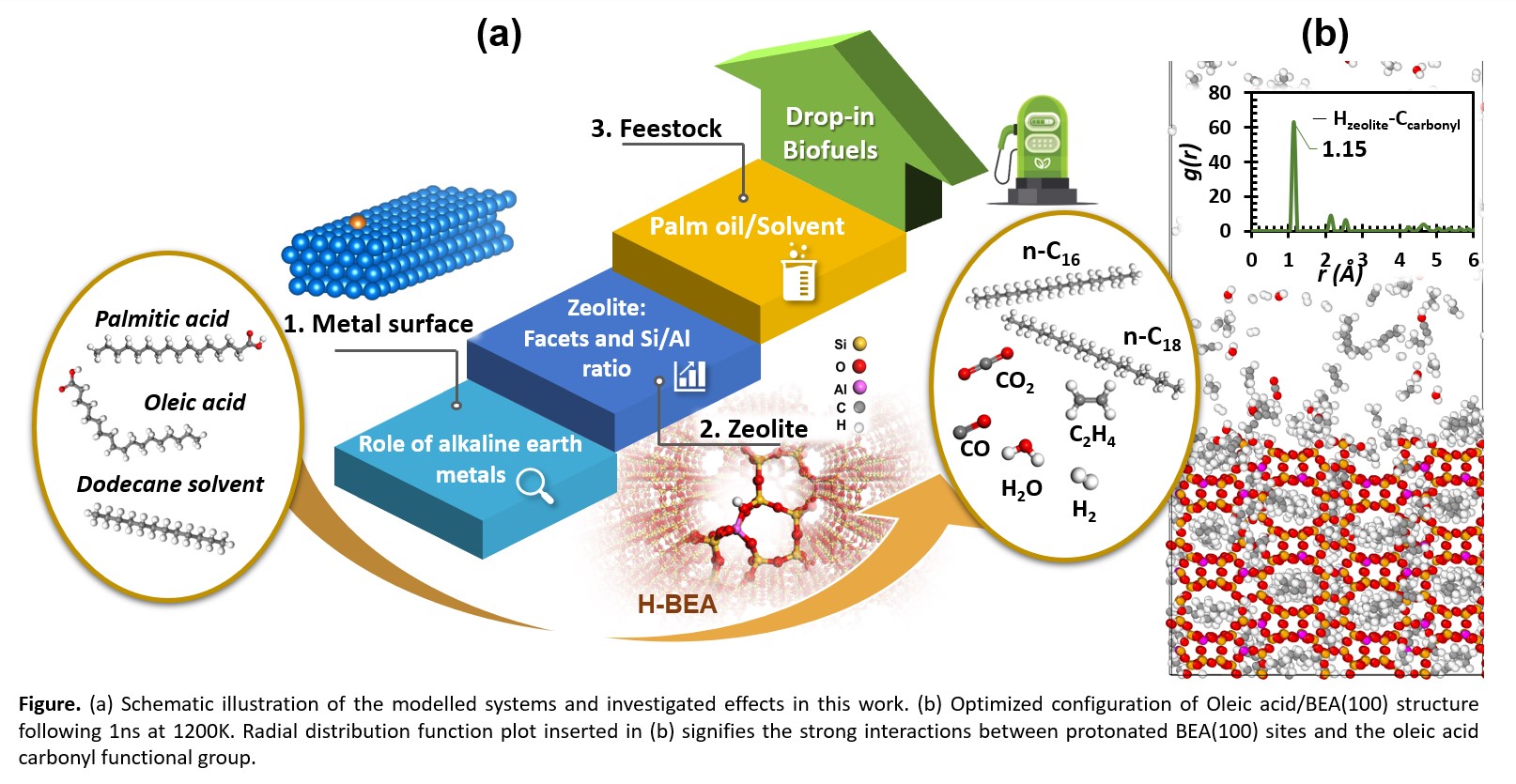2023 AIChE Annual Meeting
(291b) Elucidating the Role of Alkaline Earth Metal Promoters and Zeolite Support Acidity on Palm Oil Catalytic Upgrading: Insights from DFT and Reactive Molecular Dynamics
Authors
A variety of heterogenous microporous heterogeneous catalysts have been investigated for the HDO of modeled palm oil compounds [3,8â10]. Among such structures, tuned aluminosilicates incorporated with metal sites, have attracted great attention towards the decarboxylation/decarbonylation (deCOx) and hydrodeoxygenation (HDO) of bio-oils catalytic upgrading [8,11â14]. Despite recent experimental studies, the upgrading of long-chain palm oil compounds has not yet been explored computationally. Thus, it remains unclear how the competitive mechanism proceeds to take place on the catalyst active-sites.
In this work, the upgrading of oleic acid and palmitic acids, two representative modelled palm oil molecules, have been examined using DFT calculations and ReaxFF simulations to study the role of (1) alkaline earth metal promoters on Ni(111) surface and examine the (2) activity of Brønstedâacid sites incorporated into (001) and (100) BEA-zeolite support. The Results from DFT reflected the effect of Mg2+ on improving the bio-oilsâ adsorption energy, reducing the OâM separation distance, and elongating the CâO bond length towards HDO upgrading. Notably, correlating the periodic number of the ionic promoter active-sites with the palmitic acid adsorption energy and OâM separation provided a linear relationship with R2=0.988 and R2=0.987. Such derived linear correlations are valuable in further anticipating the reactivity trends of transition metal-based modified catalysts. Moreover, ReaxFF simulations demonstrated the greater deCOx reactivity of BEA(100) compared to (001), revealing the molecular-level interactions governing the aggregation of oleic acid and palmitic acid on both facets. Aside from the effect of facets, different Si/Al ratios (all-silica, Si/Al=7, and 15), reaction temperatures (300K, 700K, and 1200K), and feedstocks (bio-oil/dodecane) were tackled. The protonated sites induced the zeolite activity as depicted by the higher number of CO/CO2 and H2O produced, also signified by elevated OOleicAcid-HBEA g(r) peaks and reduced separation distances. Besides, the presence of dodecane gave rise to the bio-oils conversion and hydrocarbon yields quantitatively examined by the ratio of Cfeedstock/Chydrocarbon-fuels production. Although increasing the temperature from 700K to 1200K enhanced the palmitic acid and oleic acid conversions, a reduction in n-C16 and n-C18 yields was found coupled with higher ethylene production. This contribution deepens the fundamental understanding, at the molecular level, of the role of modified nickel surfaces and tuned BEA-zeolite supports to pinpoint the optimum factors governing the catalytic upgrading of long-chain bio-oil feedstocks towards value-added hydrocarbons and potential biofuels.
This work has been partially financed by Khalifa University of Science and Technology under the Research and Innovation Center on CO2 and Hydrogen (RICH) and the Catalysis and Separation Center (CeCaS) (projects RC2-2019-007 and RC2-2018-024, and AARE19-223).
References:
- [1] B.B. Uzoejinwa, X. He, S. Wang, A. El-Fatah Abomohra, Y. Hu, Q. Wang, Energy Convers. Manag. 163 (2018) 468â492.
- [2] Y. Makkawi, Y. El Sayed, M. Salih, P. Nancarrow, S. Banks, T. Bridgwater, Renew. Energy 143 (2019) 719â730.
- [3] B. Yoosuk, P. Sanggam, S. Wiengket, P. Prasassarakich, Renew. Energy 139 (2019) 1391â1399.
- [4] S. Kim, E.E. Kwon, Y.T. Kim, S. Jung, H.J. Kim, G.W. Huber, J. Lee, Green Chem. 21 (2019) 3715â3743.
- [5] T.P. Vispute, H. Zhang, A. Sanna, R. Xiao, G.W. Huber, Science (80-. ). 330 (2010) 1222â1227.
- [6] P.L. Cruz, E. Montero, J. Dufour, Fuel 196 (2017) 362â370.
- [7] K.S. Arias, M.J. Climent, A. Corma, S. Iborra, Energy Environ. Sci. 8 (2015) 317â331.
- [8] O.B. Ayodele, H.F. Abbas, W.M.A.W. Daud, Energy Convers. Manag. 88 (2014) 1111â1119.
- [9] S. Xing, Y. Liu, X. Liu, M. Li, J. Fu, P. Liu, P. Lv, Z. Wang, Appl. Catal. B Environ. 269 (2020) 118718.
- [10] M. Peroni, I. Lee, X. Huang, E. Baráth, O.Y. Gutiérrez, J.A. Lercher, ACS Catal. 7 (2017) 6331â6341.
- [11] K.N. Papageridis, N.D. Charisiou, S. Douvartzides, V. Sebastian, S.J. Hinder, M.A. Baker, S. AlKhoori, K. Polychronopoulou, M.A. Goula, Renew. Energy 162 (2020) 1793â1810.
- [12] I. Hita, T. Cordero-Lanzac, G. Bonura, C. Cannilla, J.M. Arandes, F. Frusteri, J. Bilbao, J. Ind. Eng. Chem. 80 (2019) 392â400.
- [13] M. Hellinger, H.W.P. Carvalho, S. Baier, D. Wang, W. Kleist, J.D. Grunwaldt, Appl. Catal. A Gen. 490 (2015) 181â192.
- [14] J. Xing, L. Song, C. Zhang, M. Zhou, L. Yue, X. Li, Catal. Today 258 (2015) 90â95.

